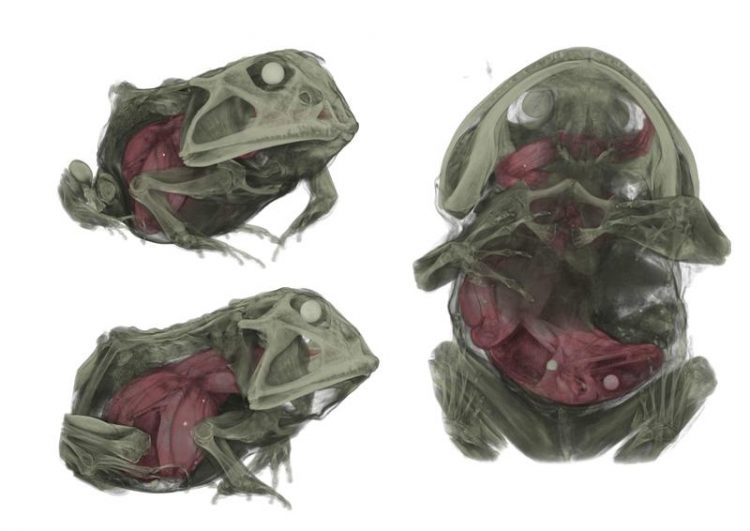A frog in the throat

A frog in the throat. Dr Thomas Kleinteich, Kiel University
“I work as a research associate on a project into the sticky characteristics of amphibian tongues”, says Dr Thomas Kleinteich, from the Functional Morphology and Biomechanics working group at the Zoological Institute at Kiel University.
He generates three-dimensional computer models of animals using a micro-CT scanner, which works in a similar way to a medical CT scanner but is designed for investigating small objects. Kleinteich: “To do so, I use museum specimens conserved in alcohol. In this case, it is a South-American horned frog Ceratophrys from the collection at the Zoological Museum in Hamburg.”
When analysing the scan, Kleinteich found that another animal was present inside the frog: “We have known for a while that horned frogs are able to eat very large prey.
Last year I was able to show experimentally, that horned frogs can produce extremely strong adhesive strength with their tongues, which they also need in order to catch larger prey. With the micro-CT I am able to show, for the first time, how such a large catch can even fit inside a horned frog.”
The image of the frog with a frog in its throat won a competition in May from the CT-manufacturing company “Bruker microCT”.
Original publication:
Kleinteich, Thomas: “To have a frog in the throat: micro-CT imaging of anuran prey in Ceratophrys ornata (Anura: Ceratophryidae)”, in: SALAMANDRA – German Journal of Herpetology, Volume 51, No. 2, June 30th 2015.
Previous press releases on Dr Kleinteich's research:
www.uni-kiel.de/pressemeldungen/index.php?pmid=2014-172-froschzungen
www.uni-kiel.de/pressemeldungen/index.php?pmid=2014-021-klebezungen
www.uni-kiel.de/pressemeldungen/index.php?pmid=2013-270-teufelsrochen
Contact:
Dr Thomas Kleinteich
Spezielle Zoologie – Functional Morphology and Biomechanics
Tel.: +49 (0) 431 / 880 – 4509
E-Mail: tkleinteich@zoologie.uni-kiel.de
http://www.uni-kiel.de/pressemeldungen/index.php?pmid=2015-202-frosch-im-frosch&…
Media Contact
All latest news from the category: Life Sciences and Chemistry
Articles and reports from the Life Sciences and chemistry area deal with applied and basic research into modern biology, chemistry and human medicine.
Valuable information can be found on a range of life sciences fields including bacteriology, biochemistry, bionics, bioinformatics, biophysics, biotechnology, genetics, geobotany, human biology, marine biology, microbiology, molecular biology, cellular biology, zoology, bioinorganic chemistry, microchemistry and environmental chemistry.
Newest articles

Properties of new materials for microchips
… can now be measured well. Reseachers of Delft University of Technology demonstrated measuring performance properties of ultrathin silicon membranes. Making ever smaller and more powerful chips requires new ultrathin…

Floating solar’s potential
… to support sustainable development by addressing climate, water, and energy goals holistically. A new study published this week in Nature Energy raises the potential for floating solar photovoltaics (FPV)…

Skyrmions move at record speeds
… a step towards the computing of the future. An international research team led by scientists from the CNRS1 has discovered that the magnetic nanobubbles2 known as skyrmions can be…





















